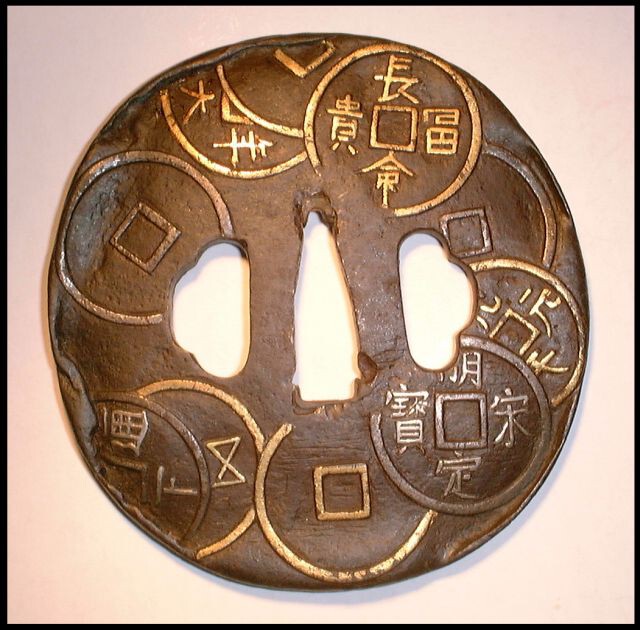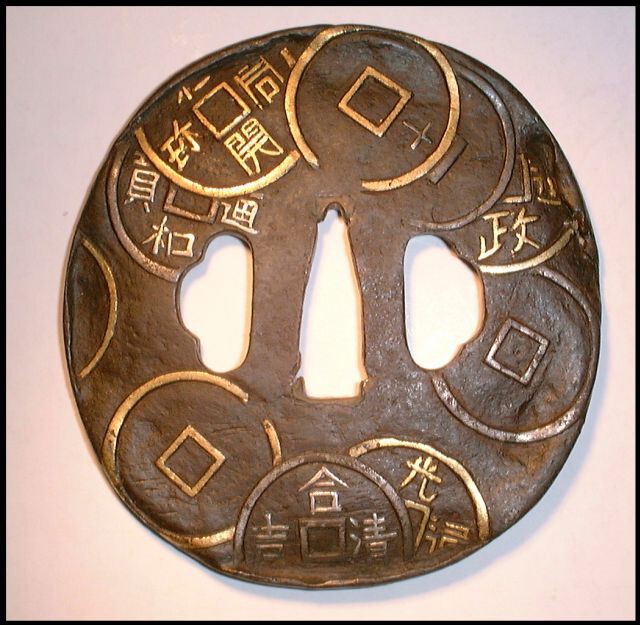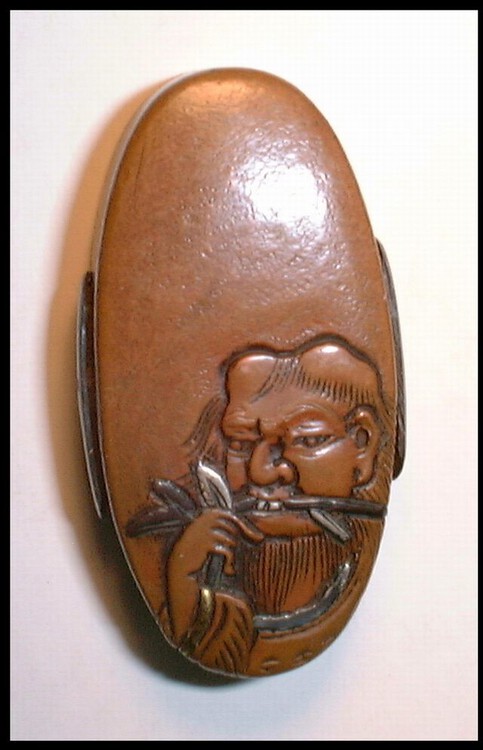-
Posts
815 -
Joined
-
Last visited
-
Days Won
1
Everything posted by docliss
-
Thank you both for your helpful comments on my kozuka. Some time ago, in an attempt to understand how the patination of soft metal kodōgu is retained in spite of a loss of the profile of the nanako, I suggested that this loss may not be entirely due to ‘wear’, but also to a correction of the stresses produced in the metal by the creation of the nanako and brought about by the natural elasticity of that metal. I even went so far as to suggest that such kodōgu might undergo these changes after storage, even without wear, for a number of centuries. I do not recall any feed back over this suggestion, and would be interested to hear Ford’s thoughts on this. Regards, John L.
-
Do any members have any comments to make on this mumei, shakudō kozuka, The metal is of high quality and of a rich, black coloration, and the nanako, not shown clearly in these photographs, is very worn – almost smooth at the upper end. The reverse is polished and undecorated. Regards, John L.
-
My grateful thanks to you all for your replies to my query. The incredibly wide range of knowledge that exists among the NMB members never ceases to amaze me. John L.
-
Are any of our widely-read members able to identify the coins depicted on this tsuba? Are they representative of genuine coinage or simply stylised and with random kanji? With my thanks in advance, John L.
-
Ford, please accept my apologies for not having responded to your generous posting of the Joi examples - I was rather hoping for some more responses before replying myself. While agreeing that there is a certain lack of 'delicacy' in my own f-g, I do wonder if this is appropriate to the chosen subject, and am still not sure about its provenance. Like you, I also am waiting for some members to venture some comments! John L.
-
Your comments on this pair of fuchi-gashira would be greatly appreciated. On a delicate, toad-skin ishime, copper surface, Shinnō is depicted in shishiai-bori on both pieces. On the fuchi, the hermit holds a silver brush and a tablet on which is visible part of the pa-qua. He has long, kebori hair, silver eyes and teeth, and gold ornamentation on his robe. There are vertical yasurime on the tenjō. A similar figure is depicted on the kashira, eating silver and shakudō bamboo. There are shakudō shitodome in situ. A similar fuchi-gashira, no 64, is described on p. 36 and illustrated on p. 35 of Rucker’s catalogue of the Gōda Collection of Japanese Sword Fittings in the Metropolitan Museum of Art. This latter pair is inscribed Issandō, with a gold seal for Nagaharu. The quality of this work is stunning, with the join between the tenjō and the koshi of the fuchi almost undetectable. This quality, together with the presence of vertical yasurime on the tenjō, makes me wonder …. Regards, John L.
-
Oh dear, I think I am losing the plot! Apart from the treatment of the tama jewel, I just cannot see any similarity between the f-g of Simon and the work of the Hirado Kunishige school. Surely the organisation and simplicity of Simon’s image is completely lacking in the ‘fussiness’ normally associated with Kunishige work. I think I’ll go with Marc’s suggestion of H 03697.0 as the possible maker of this pair. John L.
-
Curran, is your statement ‘later period or possibly Edo Higo’ based upon the variation in width of the niju karakusa design; the quality of the iron; the lack of spontaneity of the design; or all three? Also, the surface of the kojiri looks as if the entire surface has been cross-hatched and the gold decoration applied upon this as on overlay, rather than an inlay – is this another indication of its later production? I would love to hear your rationale. John L.
-
Dear Brian As Curran suggests, the mei on your tsuba is not an attempt at a forgery of that of the Mito master (H 01415.0), since it uses a completely different kanji for ‘toshi’. Neither is it by the single artist listed by Haynes as having a similar mei to yours (H 01416.0), since there are significant differences in the construction of these two. Rather, it is by a second, unrecorded artist using the same kanji as the latter, and working with iron in a much more 'rustic' style than that of the Uchikoshi artists. Regards, John L.
-
Dear Brian (sorry Stephen) Your fuchi-gashira are not by Uchikoshi Hirotoshi (H 01416.0), the only artist listed by Haynes as using these kanji, but by an unrelated artist using a similar mei. There have been several postings about these artists, including one on Sun. Sept. 23, 2007, initiated by yourself with images exactly like those you have posted today. John L.
-
One can readily accept that the rectangular form of seppa-dai on some Namban tsuba may have its origin in the rectangular shape of the hilt of the Chinese sword. One can also accept the possibility that this ‘quaint’ feature persisted on those tsuba that were made in the C18 for sale to Europeans. But this does not explain why so many ‘made in Japan’ tsuba of this group, clearly intended for the local market and for mounting on Japanese blades, persisted with this impractical anachronism. John L.
-
This is an outstanding example of the genre, with very high quality undercutting and is ubu, without added ryō-hitsu. The seppa-dai is of the conventional Japanese type. Placing these tsuba in a timescale is always very difficult, and the conceit of the ‘floating ball’ suggests that it may not be quite as early as I would have otherwise thought. Improved metalworking techniques means that the quality of later work is often quite high. John L.
-
Reinhard states that ‘quite often [Namban tsuba] seem to be made by people, who were not familiar with NihonTo and [the] basic principles of tsuba’. Hamilton made the same suggestion in 1975 (The Peabody Museum Collection of Japanese Sword Guards, pl. XXVII, no 1) when he suggested that decorative seppa-dai were ‘made outside Japan where the oval shape and function of the Seppa Dai were unknown’. I cannot accept either of these statements. The Chinese were very familiar with the Japanese sword, it being claimed that almost 1,130,000 were exported to China during the 1450-1550 period (Fukasawa (1998). Ainu Archaeology as Ethnohistory, p. 64). And it is extremely unlikely that the Dutch East India Company undertook the manufacture of tsuba without being familiar with their market. I would prefer to consider that it is we who are currently ‘not familiar' with the basic principles of this group of tsuba! John L.
-
In 2001 I trawled through all of the Namban tsuba in the collection of the Birmingham Museum and Art Gallery — as total of 53 by my calculation — and can reassure Reihard that ‘his’ tsuba, 687’30, is still there and is ex the Sir Charles Hyde, Bt collection. The notes that I made at the time state ‘solid, square rim; square seppa-dai, undecorated but with hammer marks; asymmetrical design of vegetation with leaves and tendrils (? vines) and foxes; later ryō-hitsu; uninscribed; 8.7 x 8.7 cm'. I was clearly not very impressed by its age at that time, but would love to see it again. John L.
-
I agree with Curran - a very interestinng tsuba. I also agree that it cannot be labelled 'auriculate', although it clearly demonstrates a European influence which, considering its period of manufacture as early C18 to early C19, is not at all surprising. It is conceivable that, without the mei, the NBTHK might have classified this as 'Namban'! John L.
-
Dear Piers From the bandwagon, so as to speak, I was not stating that gilded seppa-dai are unusual, but rather commenting upon the removable gold cover on Barry’s tsuba. Decorative seppa-dai are obviously one of the defining characteristics of this group of tsuba, and what I call ‘fortification’ designs, such as this, with gold, nunome-zōgan decoration, are not uncommon. Clearly this decoration would have worn away very rapidly after mounting, however. Your tsuba, with its chrysanthemoid rim, profuse gilding and contemporaneous ryō-hitsu, does not appear to have the same, high quality that is apparent on Barry’s tsuba, with its excellent undercutting — am I correct in this, or is it just not so visible in your photograph? It is, I suspect, rather later in date — probably late C18. Regards, John L.
-
Barry’s tsuba is, indeed, a very fine example of this group. At 85 x 75 mm in size, it falls just inside the possible katana range and, again, the kozuka-hitsu is a later modification. The quality of both the undercutting and the gilding are both of a very high standard, and I love the manner in which the gilding on the rim has differentially worn away. The gold plate on the seppa-dai is a very unusual feature. The tsuba clearly falls within our current definition of the Namban group. But C17? The concavo-convex profile that Barry describes indicates to me a European influence and a possibly rather later date of manufacture. The article by Boxer that Barry mentions (Boxer, C.R. “European Influences on Japanese Sword Fittings: 1543-1853” in Transactions and Proceedings of the Japan Society of London, vol. 28, 1930-31) is interesting in that it proposed an impractical sub-division of the Namban group into three sections. Those tsuba made in 1542-1639, during the Portuguese influence, were to be labelled ‘Namban’; those deriving their inspiration from Dutch designs would be labelled ‘Komo’; and those in the Chinese style ‘Canton’. But even Boxer was forced to admit the difficulty in distinguishing between these three sub-divisions, and his article is mired in the impractical group definition of his time being ‘any tsuba that demonstrated a foreign influence’. I cannot agree with him that a beaded (chrysanthemoid) rim indicates an earlier date of manufacture. One can only assume that it represents a Japanese modification of the earlier Chinese imports, and seems to me to be a later, rather than an earlier, characteristic. Talking of these imports, they seem to be incredibly rare — even Kitamura, the director of the Namban Bunka-kan in Osaka-shi, acknowledges that there is no example of such tuba in this collection (Personal Communication, 1998). But one such may be no 354, p. 354 of Ogawa’s Japanese Swords and Sword Furniture in the Museum of Fine Arts, Boston. John L.
-
I cannot agree with Reinhard that to depict the taotie faces upside down is ‘quite contrary to [the] Japanese conception of tsuba’. Yoshimura Shigeta illustrates five such tsuba of the auriculate type on pp. 63-67 of his book, and upon every one of these this is a constantly recurring feature. John L.
-
Thank you, Chris, for your kind comments. The only recent publication that I know of about this group is in Japanese, and is quite difficult to track down. It is: Shigeta, Yoshimura. Namban Tsuba: Akogane no Desain, Tokyo, 1998. Both of the tsuba that you posted demonstrate all of the defining characteristics of the group, and both are quite good examples of C18-C19 work — the second especially so, with its excellent quality of undercutting and its later, added, kozuka-hitsu. It is also unusual to see two distinct diaper designs on the seppa-dai. Regards, John L.
-
Nick’s postings do, somehow, seem to stimulate discussion! Reinhard requests a definition of the label ‘Namban tsuba’, and this question was answered by Ogawa when he proposed that “Those tsuba that are today called Namban (literally ‘southern barbarian’) appear to have been produced in China or by the Dutch East India Company in India and imported from the end of the 16th century. The category also includes reproductions of these imported pieces, later made in Japan”. (Ogawa (1987). Japanese Swords and Sword Furniture in the Museum of Fine Arts, Boston, no. 353, pp. 352 and 353.) The two auriculate tsuba that Reinhard posts are not, I believe, ‘made out of parrying guards taken from Western swords’, but are Namban tsuba by the above definition. Such guards are very constant in form, comprising two decorative lateral plates separated by a central, plain biconcave plate that includes the seppa-dai, and are probably influenced by the counter-guard that appeared on European swords from the early 17th century. These auriculate guards commonly have at their upper and lower ends a taotie, and their design may incorporate ‘swan-neck drawer handles’ — another demonstration of a European influence. Where a kebori, VOC logo features on the seppa-dai and would be hidden when the guard is mounted, as in Ford’s image, this is probably a ‘trade mark’ indicating its manufacture by the Dutch East India Company. But where this is fully incorporated into the design, as in Reinhard’s first image, this may merely represent the incorporation of a commonly seen logo into the design. The ita-tsuba illustrated by Ford is not a Namban tsuba, but rather a Hizen one demonstrating a strong namban influence. The presence of rectangular nakago-ana remains enigmatic, but I would not entirely discount the possibility that later workers, manufacturing tsuba as shiiromono that would requite alteration of the nakago-hitsu before mounting, found such alteratation easier to carry out on a rectangular opening rather than on the conventional, triangular one. John L.
-
To follow Ian’s very knowledgeable comments on the Chinese influence upon the Namban group of Japanese sword guards … Trade records describe crude and symmetrical guards with purely Chinese designs as arriving in Japan from China around 1600 (Wada (1913), Hompō Sōken Kinkō Ryakushu, p. 90). At this time, Japan was enjoying a brief respite during several centuries of continuous civil war, and Zen Buddhism was becoming increasingly influential. The status of metalworking artists increased, and their work adopted a pictorial style of design with an increasing decorative use of the soft metal alloys. Japan was thus highly receptive to these highly innovative designs from China. Local artists, especially in Nagasaki, Hirato, Hakaka, Kyōto and Aizu, extensively copied these imported tsuba, and it is stated that ‘these designs were welcomed by the public, which liked novelties, and there is the impression that they suddenly overwhelmed a generation’ (Homma and Satō (1935-36), Nihon Tō Kōza: vol. VI, Kodōgu, part I, p. 179). As a result of these activities, domestically made copies of these Chinese guards became very numerous. But this period of nationwide popularity is now considered to have reached a peak as late as the end of the 18th and the early 19th centuries, which is probably the date of this tsuba's manufacture. John L.
-
Dear Steve The broad shape of the two suhama-gata ryō-hitsu suggests to me a Shōami attribution, and the style of the work as being either Akita or Shōnai. May I therefore hazard an attribution of C18 work by the Akita-Shōami-Denbei group? John L.
-
Dear Andrey Most collectors will be aware of the large number of tsuba that are inscribed Seiryūken Eiju in sōsho and bear a gold hon-zōgan seal. These were at one time attributed to Okamoto Naofusa (H 06602.0), a student of O. Harukuni and the adopted son of O. Naoshige. But the number of such tsuba and the wide range of quality among them, together with variations in the mei and several different seals, suggests that there were a number of artists producing such work. The better of these demonstrate the high quality of iron plate that characterises Tetsugendō work, while others are of very poor quality. To gather together a number of such guards and to compare their technique, quality and the variations of mei and seal would be a valuable and interesting research project for one of the NMB members.. Regards, John L.
-
Ford, you are probably well aware of von Shroeder’s objection to the nomenclature of ‘lost wax process’, commenting in 1981 that “the only substance which is not lost is the wax, which can be collected and subsequently used again and again”. On this basis he preferred the term ‘lost form’ to the traditional one of ‘lost wax’. John L.











